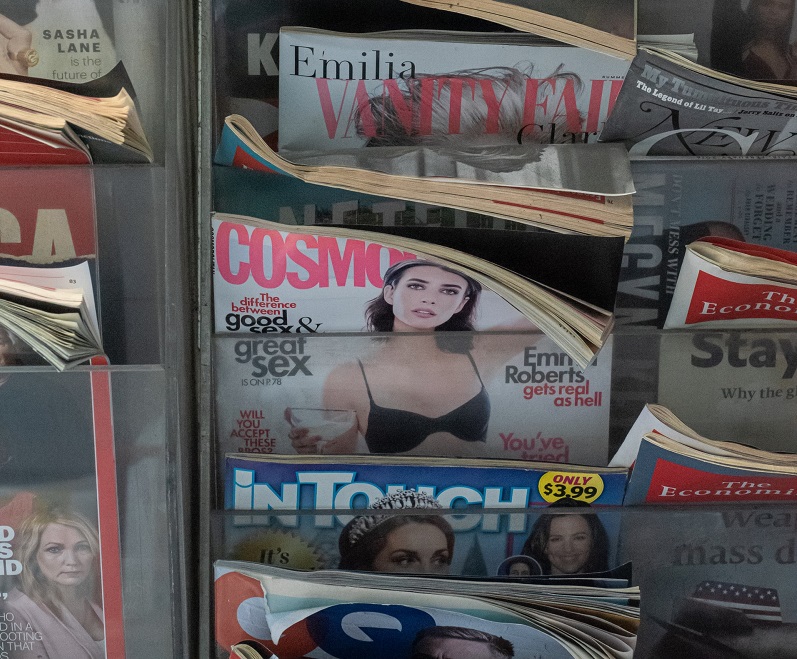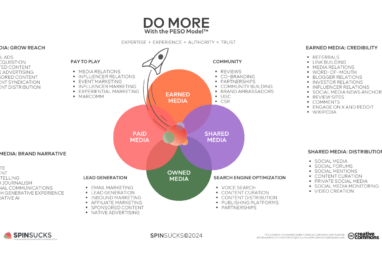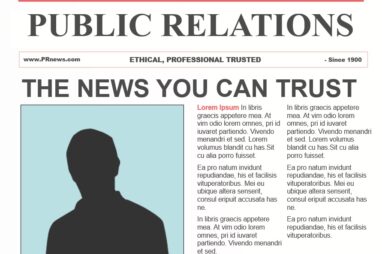Survey result releases are becoming obsolete
Lazy PR tactics won’t pass the ‘media literacy test’ after Government U-turn
About the author
Katie Watts wrote this article as part of a CIPR Professional PR Diploma assignment while studying with PR Academy.

“I’m really excited that 8 Out of 10 Cats is returning to E4. What Britain needs now more than ever, is a panel show about surveys and statistics. Well, that and six months’ supply of food and medicine.” That was the trademark wry wit of comedian Jimmy Carr, quoted in a Channel 4 press release in March 2019, as the UK’s original planned ‘Brexit’ date approached.

It’s hard to ignore the implied irony though – and generally the tongue-in-cheek format of the programme. Any PR who has taken the linear route through the industry – from junior press officer onwards – will have at some point written a press release based on a commissioned survey. More often than not, this will have been part of an omnibus. Borrowing from polling company Ipsos Mori’s own sales pitch, “when representivity (sic), speed and cost efficiency are critical”, an omnibus allows you to include questions alongside other research, distributed to a national or regionally representative sample of the UK public.
In 2020, Carr’s cynicism has foreshadowed a recent shift in policy in the UK, which could eventually leave ‘quick win’ PR survey press releases in Room 101 (if you’ll forgive another panel show reference). Not only that, when the policy is played out, it’ll force PRs to evolve tactics for decades to come.
The problem with polling
PR-driven omnibus surveys often fall into two categories.
First, the irrelevant survey. As a journalist contact recently recalled, a survey which claimed the Danish is the favourite pastry of two in three mums didn’t make the news list, because… so what? It wasn’t newsworthy, current or frankly, ground-breaking.
Alternatively, a survey appears wholly unrelated to the company that commissioned it. One press release fell into the shared inbox of the editorial team I work in, crowning cheese on toast the king of snacks… according to a cash savings service.
The second category is a much wilier thing – a survey that does manage to tap into something recent and relevant, or connects to a product or service being launched. However, it is largely ineffective, unless your objective is to get simple brand name mentions. Write-ups will rarely spend precious word-count on the commercial message, instead running the statistics alone.
Back to my contact, who received a survey on the most common sleep positions, intended to promote (and ultimately sell) a new mattress. On instruction from his editor, he ignored the new mattress and just focused on the sleep positions.
Both types are major gripes, according to journalists surveyed by Gingercomms and its polling arm Perspectus Global: sending over branded press releases which do not contain anything newsworthy (59% said), and expecting too much branding in the resultant editorial coverage (43%).
Whichever category your last survey press release has fallen into, it was likely used as a ‘quick win’ PR tactic, often to appease clients in a slow month, and this fails to take on board feedback and critique from the media industry, regulators and the public.
Omnibus surveys suffer a number of flaws in today’s media landscape:
- Too often, transparency on the survey methodology is lacking, either in the release or when reported – this is a subject of increased examination by press regulators such as IPSO. For example, a 2018 House of Lords review highlighted a number of cases of misreported polling data – including the Daily Express headline, “98% say no to EU deal”, which did not make clear that the figure came from a phone survey of Daily Express readers.
- ‘Survey fatigue’ skews results. It’s a well-documented phenomenon, which results in the quality of responses dipping further into the omnibus, or as a result of mixed topics.
- The results often aren’t comparative. Unless the same questions are repeated year on year, or compare segments of society, they don’t provide any sense of difference or change, making their newsworthiness limited.
- No matter how hard we try, PRs are guilty of confirmation bias and leading questions. We design surveys with certain headlines in mind, whereas a trained researcher is much better at objectivity.
- Representativeness is a false front. A sample research population will always be weighted towards the very kinds of people who will take the time to actually fill in the survey, either out of interest or in exchange for reward.
Let’s return to the Gingercomms poll of journalists mentioned earlier. Arguably, a survey of just 200 national news and lifestyle journalists isn’t a robust sample and isn’t very representative – it only includes national journalists, and, in any case, the sample size cannot demographically represent all of them. On closer inspection, when asked about the “biggest mistakes” PRs make when pitching, the available options are riddled with confirmation bias and are leading – one example reads: “sending over branded press releases which do not contain anything newsworthy”. So, ironically, while the poll supports the case for ditching the survey press release, in the spirit of the argument, let’s not consider it good enough evidence to rip up your survey company’s business card.
At this point, you could be forgiven for thinking: “our surveys still get picked up, the brand name lands, and we can present our client with a nice coverage book of news items mentioning their company – what’s the problem?”
But journalists publish what their readers and viewers want, and there’s a looming, progressive piece of policymaking on the horizon which – if you are yet to be won over – may just convince you.
What’s Online Harms got to do with it?
One star piece of work going through the UK Parliamentary process is the upcoming Online Harms Bill. To be clear, I am not suggesting that relatively inoffensive PR-led survey data is harmful. But buried in the Government’s White Paper on Online Harms is a policy that, in time, will impact how every citizen consumes the media. In an effort to hand internet users some agency over their access to misinformation and other harmful (but not illegal) content online, the Government committed to a media literacy strategy.
Media literacy is not a new idea – the Communications Act 2003 handed Ofcom duties to report on media literacy in the UK. But critics have accused this policy of becoming somewhat ‘zombified’, arguing that media literacy has fallen off the legislative agenda and that Ofcom has so far been unable to do much more than report its own research around it.
Most advocates and campaigners have argued media literacy (or news literacy) should be part of the National Curriculum, specifically building on the skills needed to critically evaluate information, not just access it.
Many already provide educational resources, including the National Literacy Trust, The Economist Educational Foundation, a BBC Young Reporters and British Council partnership and an unlikely ally from overseas… Angelina Jolie. Humanitarian Jolie has in 2020 executive-produced a series of programmes with BBC Learning, BBC News World Service and Microsoft, called “My World”. Its aim is to tackle fake news by introducing students to the processes of newsgathering, accountability and transparency, while giving them the skills to critically examine stories for bias and misinformation.
But until recently, the Government had brushed off the idea of making critical media literacy part of compulsory education. It had previously tussled with its interrogators from the Digital, Culture, Media and Sport Committee – now a policy in its star Online Harms Bill, the Government in 2019 argued that it was confident media literacy is already taught across the curriculum. However, research by the National Literacy Trust found over half of primary and secondary school teachers in the UK think the school curriculum “does not equip children with the literacy skills they need” in the digital age (this survey was combined with focus groups and other stakeholder data, so I’ll allow this one figure in, confident in its robustness).
While no longer part of the EU, the UK is undoubtedly influenced by its neighbouring coalition too. The EU has launched early proposals to tackle ‘disinformation’ with a European Democracy Action Plan (EDAP), which would give media literacy a key role in improving young people’s critical thinking around fake news. Over in the US, Reuters kicked off US Media Literacy Week in October 2020 with an event to persuade young people to fact-check information ahead of the presidential election. It is also putting a journalism mentorship prize up for grabs for students entering a contest, in which they are challenged to show how they decided a real-life piece of information was trustworthy.
All things considered, the ‘zombification’ of media literacy in the UK has too been reanimated by a critical mass of events, including the Cambridge Analytica scandal, and misinformation around 5G networks and coronavirus. Appetite for media literacy is growing, with the increasing readership and role of services like the BBC’s Reality Check and Full Fact. In the context of this u-turn in the Online Harms White Paper, it’s clear that right now is the Government’s moment to put media literacy back on the agenda.
Ultimately, a national strategy on media literacy will give an upcoming generation of media consumers the critical tools they need to evaluate and analyse a piece of information in any media source and compare it with alternatives.
This will, in turn, give rise to a certain amount of welcome scepticism, whereby people will be questioning sources and the credibility of research put in front of them. Add to this, the fact that they don’t have to rely on earned or paid media anymore – they can access information directly without news or advertising.
Marketing psychologist and persuasion expert Robert Cialdini said in 2006: “With the sophisticated mental apparatus we have used to build world eminence as a species, we have created an environment so complex, fast-paced, and information-laden that we must increasingly deal with it in the fashion of the animals we long ago transcended.”
But that was then, and this is now. He could not have foreseen the impact of misinformation on the society of 2020. Blind acceptance of information provided will soon be a thing of the past, as our target audiences become more critical, objective and wise to persuasion. They will be able to evaluate the purpose of survey data, the methodology and the biases involved. And with that cynicism, they will be able to actively object to a survey’s lazy aims to gain brand mentions.
How do we respond?
Practitioners either need to use alternative tactics to achieve objectives, or we need to put out research that will actually pass the ‘media literacy test’. Ask yourself – when a news consumer finds branded information within journalism, critically assesses the PR effort and compares it to other sources, will they deem it to be relevant, credible and trustworthy?
Of course, many campaigns (and the journalists covering them) require data to back up the importance of a story. So instead of just putting a few questions into an omnibus, we need to reinforce any research we use. For example, clients should be willing to put more investment (money and time) into properly analysing available data from credible, nationwide sources like the ONS. If it’s public sector information you need, a Freedom of Information Act request is an option, too. Clients may sign off on a proper academic partnership with a university in order to model a scenario and back up a campaigning call to action. And if an omnibus survey question must be used, it should be combined with other information, such as insights from customer habits or focus groups.
So, while 8 Out of 10 Cats ironically continues to poke fun at the good old-fashioned survey, the general public will soon wise up to the lazy PR behind some (admittedly, not all) of them. Before long, the sleepwalking news consumers of today will be relics of a simpler time before widespread misinformation. As media literacy comes back on the Government’s legislative agenda, PR professionals should prepare for the future – we won’t be able to get away with this kind of work anymore. And rightly so.


